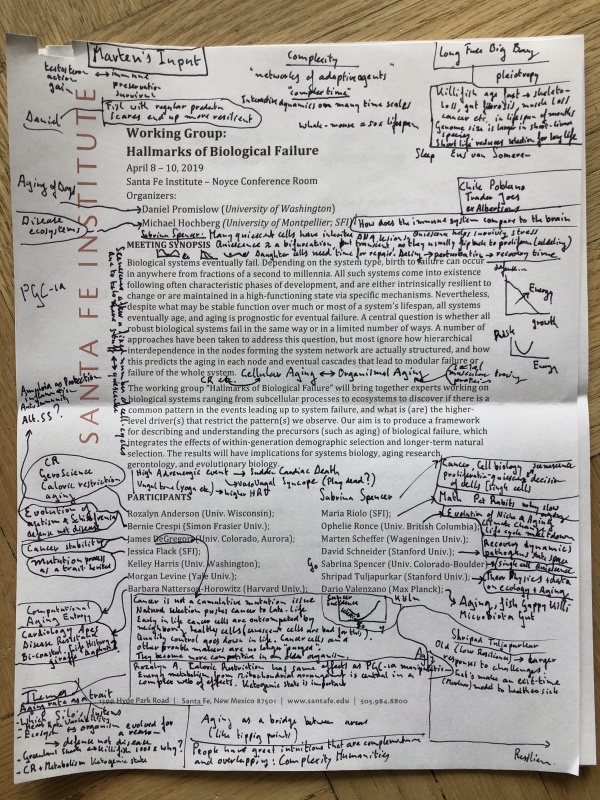Difference between revisions of "Hallmarks of Biological Failure/MartenScheffer"
(Blanked the page) |
|||
| (4 intermediate revisions by 2 users not shown) | |||
| Line 1: | Line 1: | ||
| + | {{Attendee note | ||
| + | |Post-meeting summary=[[File:Martens reflections SFI day 1.jpg|center|frameless|800x800px]] | ||
| + | |||
| + | The topic of aging turned out a really nice bridge between disciplines indeed. I thoroughly enjoyed learning about aging mechanisms that I had only distantly heard of and all that from such a wonderfully diverse group. | ||
| + | |||
| + | Reflecting on the relationship to the working group on 'multi systems human aging' within the arrow of time program and a workshop that I ran earlier with some of the same people (geriatricians, psychiatrists, animal scientists, critical care doctors) I was struck by the complementarity. | ||
| + | |||
| + | Our current group on biological failure talked mainly about the the mechanisms that affect the near-universal 'slow creep' that aging causes on a cellular level throughout the body. By contrast the other group was mainly interested in how the network of subsystems that regulate critical parameters such as mood, posture, blood pressure and temperature can lose resilience and collapse. It seems to me that those aspects might shed more light on the wide variation in health outcomes for otherwise similarly aged (on a cellular level) persons. It could be cool, in the coming years to convene a workshop that combines the interests of the two groups. It would stretch the diversity of viewpoints even further, but the common thread of aging should ensure that we get another exciting synergy going. | ||
| + | |Reference material notes=Quantifying resilience of humans and other animals in PNAS 2018 is a review that covers ideas generated by a related workshop of animal scientists and medical researchers, focusing more on the level of networks of functions at the organ and organism level. | ||
| + | }} | ||
Latest revision as of 12:17, April 10, 2019
Notes by user Marten Scheffer (Wageningen Univ.) for Hallmarks of Biological Failure
Post-meeting Reflection
1+ paragraphs on any combination of the following:
- Presentation highlights
- Open questions that came up
- How your perspective changed
- Impact on your own work
- e.g. the discussion on [A] that we are having reminds me of [B] conference/[C] initiative/[D] funding call-for-proposal/[E] research group
The topic of aging turned out a really nice bridge between disciplines indeed. I thoroughly enjoyed learning about aging mechanisms that I had only distantly heard of and all that from such a wonderfully diverse group.
Reflecting on the relationship to the working group on 'multi systems human aging' within the arrow of time program and a workshop that I ran earlier with some of the same people (geriatricians, psychiatrists, animal scientists, critical care doctors) I was struck by the complementarity.
Our current group on biological failure talked mainly about the the mechanisms that affect the near-universal 'slow creep' that aging causes on a cellular level throughout the body. By contrast the other group was mainly interested in how the network of subsystems that regulate critical parameters such as mood, posture, blood pressure and temperature can lose resilience and collapse. It seems to me that those aspects might shed more light on the wide variation in health outcomes for otherwise similarly aged (on a cellular level) persons. It could be cool, in the coming years to convene a workshop that combines the interests of the two groups. It would stretch the diversity of viewpoints even further, but the common thread of aging should ensure that we get another exciting synergy going.
Reference material notes
Some examples:
- Here is [A] database on [B] that I pull data from to do [C] analysis that might be of interest to this group (insert link).
- Here is a free tool for calculating [ABC] (insert link)
- This painting/sculpture/forms of artwork is emblematic to our discussion on [X]!
- Schwartz et al. 2017 offers a review on [ABC] migration as relate to climatic factors (add the reference as well).
Quantifying resilience of humans and other animals in PNAS 2018 is a review that covers ideas generated by a related workshop of animal scientists and medical researchers, focusing more on the level of networks of functions at the organ and organism level.
Reference Materials
| Title | Author name | Source name | Year | Citation count From Scopus. Refreshed every 5 days. | Page views | Related file |
|---|---|---|---|---|---|---|
| Doi.org/10.1073/pnas.1810630115 | 0 | 1 |
